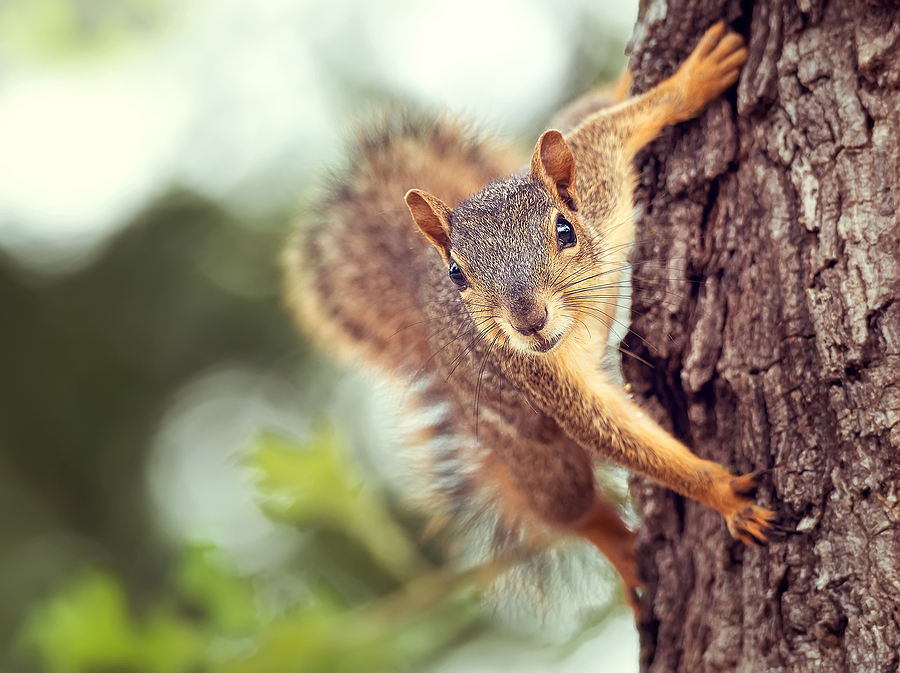Here in Tennessee, it is not hard to appreciate all the beautiful nature and surroundings of our state. But with nature comes wildlife, and squirrels are one the most common animals spotted on a daily basis by Tennesseans. This could partly be due to the fact that our state has abundant forested land, wooded lots, and flowing bodies of water, making it easy for squirrel populations to thrive. But squirrels are also prevalent in our metro, suburban, and rural regions because there are 5 different species native to our state! This includes Easter Gray Squirrels, Red Squirrels, Southern Flying Squirrels, Northern Flying Squirrels, and Fox Squirrels.
Continue reading to learn more about these five interesting and distinctive species of squirrel in Tennessee, as well as what to do if squirrels are becoming a threat or nuisance around your property.

Top Tennessee Squirrel Species
Easter Gray Squirrels
As for the most common species of the five here in Tennessee, the Easter Gray Squirrel takes the lead. You can spot these critters in parks and backyards, year-round. Their fur is gray and white, and they have longer fur on their tails. Do not confused this species with the Eastern Fox Squirrel, which is larger and has a reddish underbelly. Gray squirrels are the most problematic species in terms of critter control because they have two litters a year, which keeps their population numbers high.
Southern and Northern Flying Squirrels
Tennessee is home to both Southern and Northern Flying Squirrel species! Although they are not spotted as often as Gray squirrels and fox squirrels because they are so small, you would be surprised as just how common these fellas are around the state. Unlike other species of squirrel, flying squirrels choose to live together in the winter, staying warm and dependent as a congregation. For this reason, they are often found nesting in attics and crawl spaces, thus requiring animal removal services. One of the most tell-tale signs of a flying squirrel infestation is dark stains running down the exterior siding. These streaks are caused by their droppings and urine, as well as the oily residues on their feathers.
Fox Squirrels
Also called Eastern Fox Squirrels and Bryant’s Fox Squirrels, you will know when you are looking at one because they are the largest species in Tennessee. They get their name from their heads and face, that look just like a fox! This species of squirrel prefers to stay away from high-traffic areas like subdivisions and neighborhoods. Instead, you are more likely to spot them in nature, such as the woods or in parks, and almost always up in the trees. They are not much of a ground squirrel.
American Red Squirrels
American Red squirrels are spotted less often than Gray and Fox squirrels, but still very prevalent here in Tennessee. This is mostly because they prefer wooded areas with a lot of pine trees, and spend most of their time up in the trees. In fact, they are also known as Pine squirrels or Piney squirrels, not only because they live in pine trees, but also because their favorite food source is pine cones. They are also called North American Red Squirrel and Chickaree.
Nuisance Squirrel Problems
Squirrels are excellent climbers and small in stature, making them a prime nuisance animal in the Middle Tennessee areas. They infest roofs, attics, crawl spaces, wall voids, porches, and more, causing a long list of costly damage and unsanitary conditions. If you suspect squirrels are getting too close for comfort, or you notice that the numbers are increasing drastically in your area, you need squirrel control preventative maintenance.
Where to Get Squirrel Removal and Control in Nashville, Tennessee
Call Smoky Wildlife Control at 615-610-0962 for safe and affordable squirrel removal in Nashville, Tennessee. Our TWRA licensed wildlife control operators deliver prompt and professional solutions for nuisance squirrel problems, including extraction, exclusion, trapping, clean up, restorations, and more. We can even work with your homeowners’ insurance carrier to perform repairs for animal damages. Our animal control trappers serve both residential and commercial clients in Nashville, TN, as well as all throughout the Middle and Greater Tennessee areas. Request a free quote or advice, anytime. Need emergency animal removal? We offer after-hours service just for that.

